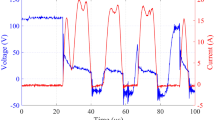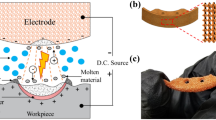Abstract
In electrical discharge milling (ED-milling), the flow field of the working medium plays an important role in the removal of discharge eroded particles from the discharge gap. In this work, a flow field model between the electrode and workpiece was established based on analysis of the moving path of the eroded particles in the discharge gap. The influence of the single-layer cutting thickness and electrode diameter on the flow field and machining performance was studied via simulations and experiments. Three kinds of new structure electrodes containing multiple holes were designed to improve the eroded particle removal efficiency. The flow field and machining performance of ED-milling with these new electrodes were studied via simulations and experiments. Through the design of multiple holes surrounding the electrode outer wall, the flushing flow field was more conducive to the removal process of the eroded particles. By adopting the newly designed electrode, the ED-milling machining efficiency was improved by 33%.










Similar content being viewed by others
Data availability
The authors confirm that the data supporting the findings of this study are available within the article.
References
Ho KH, Newman ST (2003) State of the art electrical discharge machining (EDM). Int J Mach Tool Manu 43(13):1287–1300. https://doi.org/10.1016/s0890-6955(03)00162-7
Muthuramalingam T, Mohan B (2015) A review on influence of electrical process parameters in EDM process. Arch Civil Mech Eng 15(1):87–94. https://doi.org/10.1016/j.acme.2014.02.009
Ho KH, Newman ST, Rahimifard S, Allen RD (2004) State of the art in wire electrical discharge machining (WEDM). Int J Mach Tool Manu 44(12-13):1247–1259. https://doi.org/10.1016/j.ijmachtools.2004.04.017
Fujimoto T, Okada A, Okamoto Y, Uno Y (2012) Optimization of nozzle flushing method for smooth debris exclusion in wire EDM. Key Eng Mater 516:73–78. https://doi.org/10.4028/www.scientific.net/KEM.516.73
Wang F, Liu Y, Zhang Y, Tang Z, Ji R, Zheng C (2014) Compound machining of titanium alloy by super high speed EDM milling and arc machining. J Mater Process Technol 214(3):531–538. https://doi.org/10.1016/j.jmatprotec.2013.10.015
Pillai KVA, Hariharan P, Jafferson JM (2019) μED milling of Ti-6Al-4V using cryogenic-treated Wc tool and nano-graphene powder-mixed dielectricat different discharge energy regimes. Int J Adv Manuf Technol 102(9-12):2721–2743. https://doi.org/10.1007/s00170-019-03327-8
Zhou T, Zhou C, Liang Z, Wang X (2017) Machining mechanism in tilt electrical discharge milling for lens mold. Int J Adv Manuf Technol 95(5-8):2747–2755. https://doi.org/10.1007/s00170-017-1408-5
Chakraborty S, Dey V, Ghosh SK (2015) A review on the use of dielectric fluids and their effects in electrical discharge machining characteristics. Precis Eng 40:1–6. https://doi.org/10.1016/j.precisioneng.2014.11.003
Shen Y, Liu Y, Sun W (2016) High-efficient dry hybrid machining of EDM and arc machining. Procedia CIRP 42:149–154. https://doi.org/10.1016/j.procir.2016.02.210
Liu Y, Chang H, Zhang W, Ma F, Sha Z, Zhang S (2018) A Simulation study of debris removal process in ultrasonic vibration assisted electrical discharge machining (EDM) of deep holes (dagger). Micromachines 9(8). https://doi.org/10.3390/mi9080378
Mullya S, Karthikeyan G, Ganachari V (2020) An investigation into performance of electric discharge milling using slotted tools. J Mech Sci Technol 34(6):2525–2533. https://doi.org/10.1007/s12206-020-0528-2
Wang X, Shen Y (2019) High-speed EDM milling with in-gas and outside-liquid electrode flushing techniques. Int J Adv Manuf Technol 104(5-8):3191–3198. https://doi.org/10.1007/s00170-019-04242-8
Okada A, Uno Y, Onoda S, Habib S (2009) Computational fluid dynamics analysis of working fluid flow and debris movement in wire EDMed kerf. CIRP Ann 58(1):209–212. https://doi.org/10.1016/j.cirp.2009.03.003
Wang J, Han F (2014) Simulation model of debris and bubble movement in electrode jump of electrical discharge machining. Int J Adv Manuf Technol 74(5-8):591–598. https://doi.org/10.1007/s00170-014-6008-z
Chang WJ, Xi YY, Li HW (2020) Simulation of gap flow field in EDM process uesd oil-in-water working fluid. Key Eng Mater 841:232–237. https://doi.org/10.4028/www.scientific.net/KEM.841.232
Feng G, Yang X, Chi G (2018) Experimental and simulation study on micro hole machining in EDM with high-speed tool electrode rotation. Int J Adv Manuf Technol 101(1-4):367–375. https://doi.org/10.1007/s00170-018-2917-6
Wang YQ, Bai JC, Guo YF, Huang H (2011) Investigation of the effects of dielectric inlet pressure in inner jetted dielectric EDM milling. Adv Mater Res 189-193:125–128. https://doi.org/10.4028/www.scientific.net/AMR.189-193.125
Shabgard M, Ahmadi R, Seyedzavvar M, Oliaei SNB (2013) Mathematical and numerical modeling of the effect of input-parameters on the flushing efficiency of plasma channel in EDM process. Int J Mach Tool Manu 65:79–87. https://doi.org/10.1016/j.ijmachtools.2012.10.004
Liao YS, Wu PS, Liang FY (2013) Study of debris exclusion effect in linear motor equipped die-sinking EDM process. Procedia CIRP 6:123–128. https://doi.org/10.1016/j.procir.2013.03.058
Wang Z, Tong H, Li Y, Li C (2018) Dielectric flushing optimization of fast hole EDM drilling based on debris status analysis. Int J Adv Manuf Technol 97(5-8):2409–2417. https://doi.org/10.1007/s00170-018-2141-4
Kunieda M, Kitamura T (2018) Observation of difference of EDM gap phenomena in water and oil using transparent electrode. Procedia CIRP 68:342–346. https://doi.org/10.1016/j.procir.2017.12.065
Code availability
Not applicable.
Funding
This research is supported by the Fundamental Research Funds for the Central Universities of China (grant no. 2572017BB06).
Author information
Authors and Affiliations
Corresponding author
Ethics declarations
Conflict of interest
The authors declare no competing interests.
Additional information
Publisher’s note
Springer Nature remains neutral with regard to jurisdictional claims in published maps and institutional affiliations.
Rights and permissions
About this article
Cite this article
Guo, C., Sun, S., Di, S. et al. Experimental and simulation study of the ED-milling flow field to improve its machining performance. Int J Adv Manuf Technol 113, 2513–2522 (2021). https://doi.org/10.1007/s00170-021-06804-1
Received:
Accepted:
Published:
Issue Date:
DOI: https://doi.org/10.1007/s00170-021-06804-1




